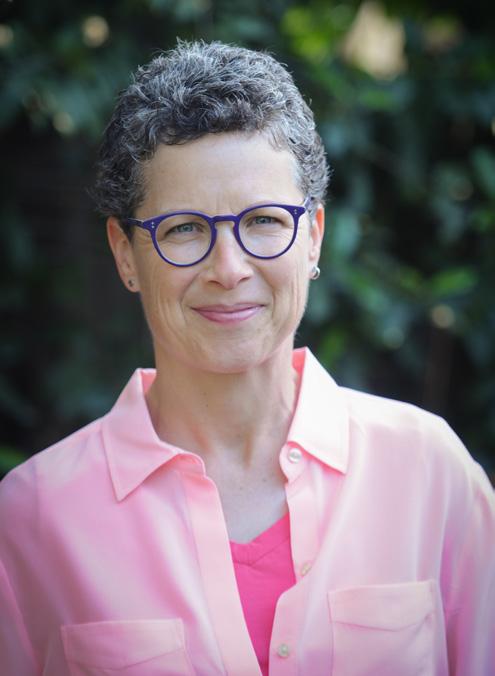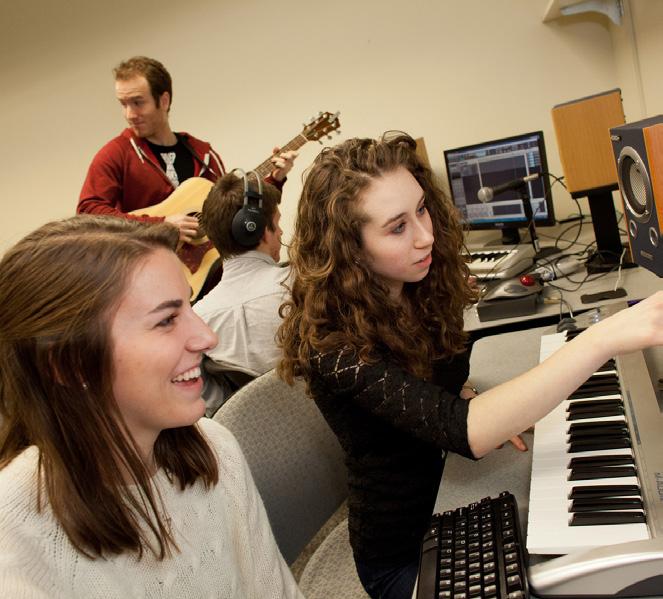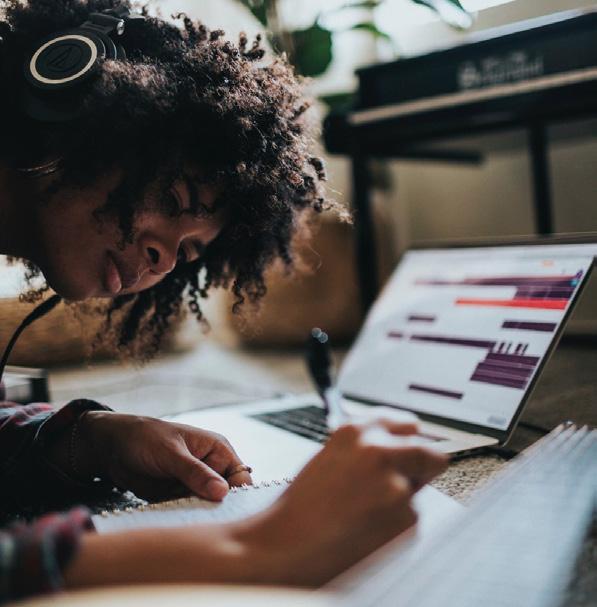
6 minute read
Innovation. What is it?

by Dr. Megan Foley CMEA Innovations Representative
Advertisement
Greetings! My name is Megan Foley, the new CMEA Innovations representative. I am truly humbled to be in this role and look forward to meeting and hearing from many of you in the coming weeks and months.
To many of us, including me, the term “innovation” suggests a technology focus: MIDI keyboards, DAWs and laptops, oh my! Perhaps these items have indeed played a role (COVID notwithstanding) in your program, particularly in the last couple of years. As I informally survey colleagues, the use of technology has indeed been either a welcome or daunting addition to their programs; some of us have awkwardly learned to embrace their use while others have seamlessly integrated them. I will confess to being one of the awkward – but enthusiastic – adopters. I tend to operate on the “I think X could be a game changer for my program, and I have no practical knowledge of it, but, hey, I’m gonna do it anyway!” mode. COVID has certainly played a role in such thinking for me. Pre-COVID, however, I had been thinking about a reshaping of my program anyway, largely because I was catering to what seemed too small a group of students. I define the concept of “innovation” as a reimagining of the traditions and tenets of music education. Going far beyond technology, I think innovation means flexibility and broadening curriculum, methods, and ideas, as well as including and honoring student voice and musical experiences they bring to the classroom.
As another year begins and I madly set up my room, organize instruments, reeds, cables, etc., I am also wondering, “Is there a place for every student in this program?” What about the students who don’t read music (and don’t really want to), students who want to learn but maybe are arriving to the program later, the kids who are there because that is the only place they feel safe, and the “lifers” who you can pencil in your roster each year? Perhaps you have a few of each in your ensembles, or you’ve begun to create spaces where you can take them all. As I look back on my musical education, I remember not only was it great fun, but it was also the place where I felt most comfortable. I was part of a traditional band/chorus/ jazz band program, yet it was clearly exclusive. We all knew how to read standard notation, albeit to varying degrees, and everyone had an instrument that “fit” the group they were in. No ukuleles or accordions in band, violins in jazz band, or laptop in marching band, much less the kid who could not read music.
I have spent the past several years thinking about and working towards reshaping my program with the intent to create spaces for any student to participate – and belong. Though the pandemic accelerated my thinking, such consideration is not new: see Allsup, 2015, 2016; Allsup & Benedict, 2008; Green, 2002; Jorgensen, 2005a, 2005b; McPhail, 2018.
Here are themes that have emerged for me:
1. Is my curriculum malleable? Students know that they can play violin in jazz band, I find/rearrange/create music for my “orchestra,” which is really a chamber ensemble with non-traditional instrumentation, but is there space to explore the music the students engage with?
2. Do students have a voice? Do they suggest repertoire?
Are they expected to arrange the tunes we agree on? Do they rehearse or conduct the group? Can the group work together without me? (Green, 2002) 3. Do I know what they are listening to? What they dig may not always be my cup of tea, but if I am open and listening to what makes them alive, they’re more likely to check out the pieces by Caroline Shaw and Zoë Keating
I’ve been raving about. We tell them to be open to everything, but are we doing the same? (Kuhn & Hein, 2021) 4. Do they know I think they are capable musicians, no matter where they happen to be in their musical journey?
Okay, but does such an approach always work? Absolutely not! At times, it is incredibly messy, uncomfortable and chaos often reigns. It also means more work for me; sometimes the students are not quite ready for leading, conducting or arranging. But, out of chaos often comes engagement. Often when I think all is lost, a student will tell me that they really loved what we did and when can we do that again! When things do work, the music made cannot only be meaningful but also very different from what was originally imagined. It is made in spaces where students are not only included, but they belong, which means the music then also belongs to them.
Obviously, we are all in different situations, with different budgets, administrative expectations, spaces, and populations. A reshaping of a program can be a daunting task, but there are ways to start small. To help students work through a challenging musical idea, we show them how to break tough things into smaller chunks, to slow things down, right? Don’t we agree that we want students to have the best experiences and to be lifelong musicians, in whatever capacity they choose? My hope is that the students know they are important and my classroom is a place where they can risk, be safe, and belong. We all know that the best music is made when everyone has ownership of the music, but what about when they have currency? That, to me, is true ownership. The best part? I always learn something.
Throughout the year, I keep notes of things I should consider for next year. At the end of the school year, I evaluate each class. I ask students about their experiences during the semester or year. What did they want to learn that they did not? What did they learn that they did not think they could or were not expecting to? Sometimes their responses lead me to broad curricular changes, sometimes they are simple ones. I research ideas, talk to colleagues, take classes and read – a lot. For me, being flexible means there is space to innovate.
In the coming issues, I plan to share ideas about creating innovative spaces for ALL students in a music program. Inclusion is important, but belonging is even more powerful. If you are thinking about your program and wanting to make some changes, I would love to hear what you’ve been thinking about! Feel free to reach out to me at mfoley@polytechnic.org.

Here’s to an innovative 2022-2023!
Allsup, R. E. (2015). Another perspective: Our “both/and” moment. Music Educators Journal, 102(2), 85–86. http://www. jstor.org/stable/24755665 Allsup, R. E. (2016). Remixing the classroom: Toward an open philosophy of music education. Indiana University Press. Allsup, R. E., & Benedict, C. (2008). The problems of band: An inquiry into the future of instrumental music education.
Philosophy of Music Education Review, 16(2), 156–173. http:// www.jstor.org/stable/40327299 Green, L. (2002). How popular musicians learn: A way ahead for music education. Routledge Publishing. Jorgensen, E. R. (2005a). Four philosophical models of the relation between theory and practice. Philosophy of Music Education
Review, 13(1), 21–36. http://www.jstor.org/stable/40495465 Jorgensen, E. R. (2005b). Transforming music education. Indiana
University Press. Kuhn, W., & Hein, E. (2021). Electronic music school: A contemporary approach to teaching musical creativity. Oxford
University Press. McPhail, G. (2018). Too much noise in the classroom?
Towards a praxis of conceptualization. Philosophy of Music
Education Review, 26(2), 176–198. https://doi.org/10.2979/ philmusieducrevi.26.2.05\
CMEA VIRTUAL MUSIC FESTIVAL


This festival is open to any school solo and/or ensemble, regardless of instrumentation:
• Band, choir, orchestra, jazz, rock/pop band, mariachi, steel drum, ukulele, guitar, hand bells, or any instrument or vocal ensemble. • Recordings of in-person performances, non-virtual, not digitally enhanced.
• Any/all styles of music are welcome! 29










